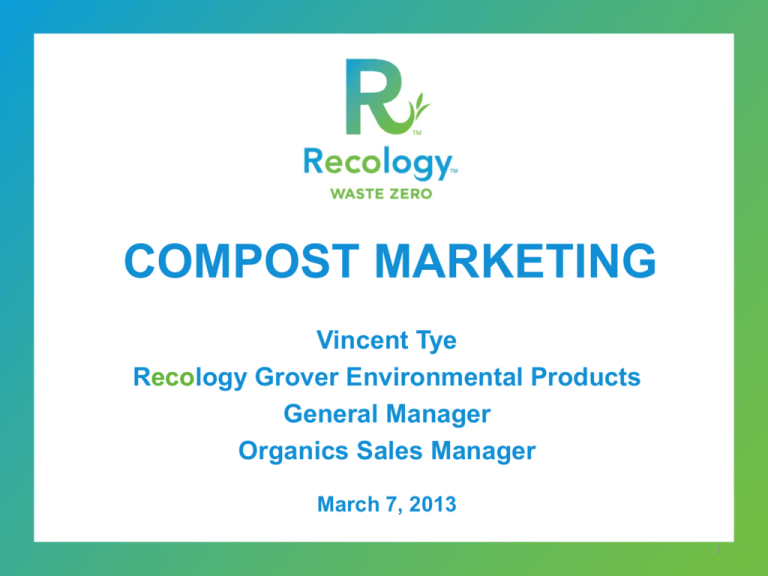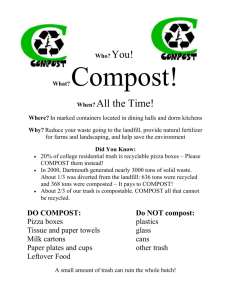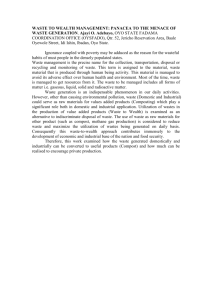16-Compost-Marketing.. - US Composting Council
advertisement

COMPOST MARKETING Vincent Tye Recology Grover Environmental Products General Manager Organics Sales Manager March 7, 2013 1 Recology Grover Site 2 Initial Observations Marketing and Sales . . . • Necessary to facility success • Important to approach systematically • Separate but related functions • Integrate with other facility functions • May be separate departments . . . • Or done by one person/team 3 Marketing and Sales • • • • • • • • • Marketing Defined The Marketing Mix The Marketing Plan Sales Defined Sales Strategy Sales Force Customer Service Sales Evaluation Conclusions 4 Definition of Marketing Marketing is the strategic process of bringing products and services to market that fulfill a customer’s value requirements. 5 Components of the Definition Marketing is … • • • • Integral to strategy A dynamic process Customer oriented Value focused 6 The Basic Marketing Mix • The Four P’s of the Marketing Mix: Product – products and services offered Place – distribution of products/services Price – adoption of pricing strategies Promotion – marketplace awareness • Framework for Marketing Plan 7 The Marketing Plan Elements of a successful plan: • • • • • Built on the Marketing Mix framework Strategically integrated with business plan Interdepartmental involvement Addresses the appropriate timeframe Based on objective market research 8 Sample Marketing Mix Product Place Price Promotion Products Offered Process Type Pricing Strategies Advertising Strategy Product Research Inventory Control Volume Discounts Trade Shows Field Trials/Testing Facility Location Published Prices Product Displays Product Branding Market Proximity Quantity Discounts Product Give-aways Bagged v. Bulk Distribution Channels Seasonal Pricing Discount Coupons Markets Served Specifier Education Market Research Technical Assistance Market Segments Market Share Customer Share 9 The Marketing Plan Structuring the Marketing Plan: • • • • • • Current market analysis SWOT analysis of current conditions Long/Short-term marketing objectives Specific achievement goals Financial analysis Evaluation mechanisms 10 The Marketing Plan • Current Market Analysis: Describe current market conditions: Products/Services Offered Who are your customers Who are your competitors Where are your markets Identify regulatory challenges 11 The Marketing Plan • Current Market Analysis: Describe current market conditions: Products/Services Offered Branded products Generic vs. Custom Products Wholesale or Retail Products Bagged vs. Bulk 12 The Marketing Plan Branded products . . . o Establish a unique product identity o Connects the product to your company o Brand name equates to quality product o Assures satisfaction of value perceptions o Name/Logo related to product value 13 The Marketing Plan Branding Examples 14 The Marketing Plan • Current Market Analysis: Describe current market conditions: Who are your customers What business are we in? What constitutes value? Where are your markets Understand market segmentation 15 Custom Blending 16 Custom Spreading 17 The Marketing Plan Market Share . . . The percentage of a given market area’s total compost sales earned by your company over a specified time period. (Breadth) Customer Share . . . The percentage of a given customer’s total compost sales earned by your company over a specified time period. (Depth) 18 The Marketing Plan • SWOT Analysis of Current Conditions: Analyze each market condition: STRENGTH WEAKNESSESS OPPORTUNITY THREAT 19 The Marketing Plan • Long/Short-term Marketing Objectives: Broadly define strategic objectives: Briefly describe 2 – 5 year context Specifically define short-term objectives Use qualitative and quantitative terms Utilize the Marketing Mix framework 20 The Marketing Plan • Long/Short-term Marketing Objectives: Broadly define strategic objectives: Briefly describe 2 – 5 year context To establish a marketing and sales presence in the Willamette Valley wine grape market by the end of calendar year 2014 21 The Marketing Plan • Long/Short-term Marketing Objectives: Broadly define strategic objectives: Specifically define short-term objectives To increase compost sales in Butte County by 5% by the end of 2014. Add two major accounts in each sales territory by the end of 2013. 22 The Marketing Plan • Specific Achievement Goals: Clearly define SMART goals: S – specific goal statements M – measurable goals A – attainable goals R – realistic goals T – timely goals 23 The Marketing Plan • Financial Analysis: Develop a marketing budget: Must be consistent with business plan Involves input from other departments Include allocations for all activities Create a living budget (reforecasting) 24 The Marketing Plan • Evaluation Mechanisms: Process for tracking goal achievement: You can manage what you measure Examine progress on broad objectives Primary focus is SMART goals Import sales reports Include mechanisms for correction 25 What is Sales? • Definition of Sales • Essential elements of the Sales process • Focus on specific elements: Developing a sales strategy Deploying the sales force Servicing the customer Evaluating performance 26 Definition of Sales Sales is the integrated process of developing, managing, and executing a mutually beneficial exchange of goods and/or services for value 27 Sales Strategy • Developing a sales strategy . . . Strategy complements marketing plan Emphasizes critical market approach: Market share Customer share Addresses customers’ value perceptions Utilizes Brand identity Promotes benefits of quality compost 28 Sales Force Deployment • Deploying the sales force . . . Knowledge of product and industry Clearly define sales territories Determine methods of deployment Understanding of strategic approach: Focus on strategic target markets Emphasize market or customer share 29 Sales Force Deployment Knowledge of product and industry . . . Product/Industry Knowledge Personal Characteristics Composting Process Honesty/Integrity Compost Uses and Benefits Confidence Product Quality Enthusiasm Regulatory and Safety Issues Acceptance of rejection Competitors and products/pricing Initiative Customer’s Industry Persistence Passion Eagerness 30 Servicing the Customer • Servicing the Customer . . . Prompt responses to inquiries/complaints Accurate and timely proposals Consistent product quality Realistic and accurate scheduling Reliable and courteous delivery system Consistent “after-sale” follow through 31 Evaluating Performance • Evaluating sales performance . . . Initiate sales reporting procedures Develop meaningful metrics Establish regular review meetings Encourage customer feedback 32 ANY QUESTIONS? Contact Information: Vince Tye 209.830.3001 vtye@recology.com 33







